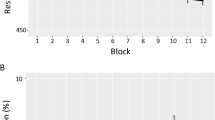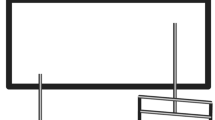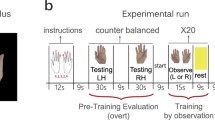Abstract
We examined the influence of the hand employed in sensorimotor learning on the acquired sequence knowledge in a serial reaction time task. Right-handed subjects trained either with the dominant or with the nondominant hand sequences of finger postures in response to a corresponding stimulus sequence. In the course of training, they were repeatedly asked to switch to the opposite hand, either responding to the original stimulus sequence with nonhomologues fingers or to the mirror-ordered sequence of stimuli with homologues fingers. When the right hand was used at acquisition, transfer to the same stimulus sequence increased with practice. In contrast, when the left hand was trained, transfer to the homologues finger sequence increased with practice. The results indicate qualitative differences in the acquired sequence knowledge controlling the dominant and the nondominant arm systems.


Similar content being viewed by others
Notes
Possible interactions between skillfulness, specific transfer conditions and expected differences in learning and motor control processes between two arm systems are a-priory difficult to predict without strict assumptions about the nature of interaction between the arm systems. For instance, the preferred hand is typically assumed to be more skillful. However, if this advantage is restricted to a special form of sensorimotor control, such as to effector-independent processes, performance differences between the parallel and mirror transfer conditions may already emerge at the beginning of training (if right hand is used in the transfer conditions). In this case these differences would not be directly related to learning of a sequence during experiment. Such an effect may not necessarily be expected, if the nondominant hand is used during transfer conditions and if it can be assumed to be less skillful in another form of control and/or learning. The impact of these or similar learning irrelevant interactions on the results may be, in our opinion, avoided, or at least reduced by focusing on learning-dependent changes in transfer performance within each type of transfer conditions.
Note: only the data of regular learning blocks were included in this analysis.
Because the last block of the experiment was always a transfer block, its influence on learning performance could not be evaluated. However, due to the counterbalancing of blocks across participants, the last block was of the parallel type for one half and of the mirror type for the other half of subjects.
In the study of Ward et al (1989) this effect was only reported for left-handers.
References
Bapi RS, Doya K, Harner AM (2000) Evidence for effector independent and dependent representations ans their differential time course of acquisition during motor sequence learning. Exp Brain Res 132:149–162
Berner MP, Hoffmann J (2008) Effector-related sequence learning in a bimanual-bisequential serial reaction time task. Psychol Res 72:138–154
Chase C, Seidler R (2008) Degree of handedness affects intermanual transfer of skill learning. Exp Brain Res 190:317–328
Clegg BA (2005) Stimulus-specific sequence representation in serial reaction time tasks. Q J Exp Psychol A 58:1087–1101
Criscimagna-Hemminger S, Donchin O, Gazzaniga M, Shadmehr R (2003) Learned dynamics of reaching movements generalize from dominant to nondominant arm. J Neurophysiol 89:168–176
Deroost N, Zeeuws I, Soetens E (2006) Effector-dependent and response location learning of probabilistic sequences in serial reaction time tasks. Exp Brain Res 171:469–480
Goble DJ, Brown SH (2008a) Upper limb asymmetries in the matching of proprioceptive versus visual targets. J Neurophysiol 99:3063–3074
Goble DJ, Brown SH (2008b) The biological and behavioral basis of upper limb asymmetries in sensorimotor performance. Neurosci Biobehav Rev 32:598–610
Grafton ST, Hazeltine E, Ivry RB (1995) Functional anatomy of sequence learning in normal humans. J Cogn Neurosci 7:497–510
Grafton ST, Hazeltine E, Ivry RB (1998) Abstract and effector-specific representations of motor sequences identified with PET. J Neurosci 18:9420–9428
Grafton ST, Hazeltine E, Ivry RB (2002) Motor sequence learning with the nondominant left hand: a PET functional imaging study. Exp Brain Res 146:369–378
Halsband U (1992) Left hemisphere preponderance in trajectorial learning. Neuroreport 3:397–400
Hazeltine E, Grafton ST, Ivry RB (1997) Attention and stimulus characteristics determine the locus of motor- sequence encoding: a PET study. Brain 120:123–140
Hicks RE (1974) Asymmetry of bilateral transfer. A J Psychol 87:667–674
Hikosaka O, Nakamura K, Sakai K, Nakahara H (2002) Central mechanisms of motor skill learning. Curr Opin Neurobiol 12:217–222
Hoffmann J, Martin C, Schilling A (2003) Unique transitions between stimuli and responses in SRT tasks: evidence for the primacy of response predictions. Psychol Res 67:160–173
Keele SW, Jennings P, Jones S, Caulton D, Cohen A (1995) On the modularity of sequence representation. J Mot Behav 27:17–30
Laszlo JI, Baguley RA, Bairstow PJ (1970) Bilateral transfer in tapping skill in the absence of peripheral information. J Mot Behav 2:261–271
Nakahara H, Doya K, Hikosaka O (2001) Parallel cortico-basal ganglia mechanisms for acquisition and execution of visuomotor sequences–a computational approach. J Cogn Neurosci 13:626–647
Nattkemper D, Prinz W (1997) Stimulus and response anticipation in a serial reaction task. Psychol Res 60:98–112
Navon D, Gopher D (1979) On the economy of the human-processing system. Psychol Rev 86:214–255
Norman DA, Bobrow DG (1975) On data-limited and resource-limited processes. Cogn Psychol 7:44–64
Park J, Shea CH (2003) Effect of practice on effector independence. J Mot Behav 35:33–40
Parlow SE, Kinsbourne M (1989) Asymmetrical transfer of training between hands: implications for interhemispheric communication in normal brain. Brain Cogn 11:98–113
Parlow SE, Kinsbourne M (1990) Asymmetrical transfer of braille acquisition between hands. Brain Lang 39:319–330
Rand MK, Hikosaka O, Miyachi S, Lu X, Miyashita K (1998) Characteristics of a long-term procedural skill in the monkey. Exp Brain Res 118:293–297
Rand MK, Hikosaka O, Miyachi S, Lu X, Nakamura K, Kitaguchi K, Shimo Y (2000) Characteristics of sequential movements during early learning period in monkeys. Exp Brain Res 131:293–304
Redding GM, Wallace B (2008) Intermanual transfer of prism adaptation. J Mot Behav 40:246–262
Remillard G (2003) Pure perceptual-based sequence learning. J Exp Psychol Learn Mem Cogn 29:581–597
Rosenbaum DA, Meulenbroek RJ, Vaughan J (1999) Remembered positions: stored locations or stored postures? Exp Brain Res 124:503–512
Sainburg RL (2002) Evidence for a dynamic-dominance hypothesis of handedness. Exp Brain Res 142:241–258
Sainburg RL, Kalakanis D (2000) Differences in control of limb dynamics during dominant and nondominant arm reaching. J Neurophysiol 83:2661–2675
Sainburg RL, Schaefer SY (2004) Interlimb differences in control of movement extent. J Neurophysiol 92:1374–1383
Sainburg RL, Wang J (2002) Interlimb transfer of visuomotor ratations: independence of direction and final position information. Exp Brain Res 145:437–447
Serrien DJ, Ivry RB, Swinnen SP (2006) Dynamics of hemispheric specialization and integration in the context of motor control. Nat Rev Neurosci 7:160–167
Stoddard J, Vaid J (1996) Asymmetries in intermanual transfer of maze learning in right- and left-handed adults. Neuropsychologia 34:605–608
Taylor HG, Heilman KM (1980) Left-hemisphere motor dominance in right-handers. Cortex 16:587–603
Thut G, Cook ND, Regard M, Leenders KL, Halsband U, Landis T (1996) Intermanual transfer of proximal and distal motor engrams in humans. Exp Brain Res 108:321–327
Van Mier HI, Petersen SE (2006) Intermanual transfer effects in sequential tactuomotor learning: evidence for effector independent coding. Neuropsychologia 44:939–949
Wang J, Sainburg RL (2004) Interlimb transfer of novel inertial dynamics is asymmetrical. J Neurophysiol 92:349–360
Ward JP, Alvis GR, Sanford CG, Dodson DL, Pusakulich RL (1989) Qualitative differences in tactuo-spatial motor learning by left-handers. Neuropsychologia 27:1091–1099
Willingham DB, Wells LA, Farrell JM, Stemwedel ME (2000) Implicit motor sequence learning is represented in response locations. Mem Cogn 28:366–375
Acknowledgments
This research was supported by Grant HO 1301/12-1 awarded to J. Hoffmann by the German Research Council (DFG).
Author information
Authors and Affiliations
Corresponding author
Rights and permissions
About this article
Cite this article
Kirsch, W., Hoffmann, J. Asymmetrical intermanual transfer of learning in a sensorimotor task. Exp Brain Res 202, 927–934 (2010). https://doi.org/10.1007/s00221-010-2184-8
Received:
Accepted:
Published:
Issue Date:
DOI: https://doi.org/10.1007/s00221-010-2184-8




